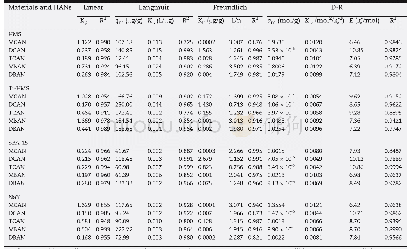《Table 7–Wheat and peanut plant N derived from15N-labeled urea (Ndff) during 2016–2017.》
 提示:宽带有限、当前游客访问压缩模式
提示:宽带有限、当前游客访问压缩模式
本系列图表出处文件名:随高清版一同展现
《Timing and splitting of nitrogen fertilizer supply to increase crop yield and efficiency of nitrogen utilization in a wheat–peanut relay intercropping system in China》
Approximately 34.6%–39.8%and 35.4%–61.9%of plant N uptake were derived from15N-labeled fertilizers in wheat and peanut,respectively(Table 7).Compared to N1,the Ndff in wheat under N2 and N3 was decreased by 8.0 and 5.9 kg ha-1(8.6%and 6.3%decrease);however,there was no significant difference between the N2 and N3 treatments.In contrast,the Ndff in peanut under N2 and N3 was increased by 46.6 and 60.8 kg ha-1(109.1%and142.4%increases).The annual total Ndff values of wheat and peanut for treatments N2 and N3 were significantly higher than that for treatment N1,by 28.4%and 43.3%.Among all treatments in wheat,Ndff from topdressing15N-labeled fertilizer was higher than that from basal15N-labeled fertilizer.In peanut,in the N2 and N3 treatments,N uptake from the second topdressing N(topdressing at R1)was approximately twice that from the first topdressing N(topdressing at G30 and G40).The topdressing N(topdressing at G40)in N3 treatments was significantly higher than that of the topdressing N(topdressing at G30)in N2 treatments,although the same15N application rate was used at both stages.
| 图表编号 | XD0029302700 严禁用于非法目的 |
|---|---|
| 绘制时间 | 2019.02.01 |
| 作者 | Zhaoxin Liu、Fang Gao、Yan Liu、Jianqun Yang、Xiaoyu Zhen、Xinxin Li、Ying Li、Jihao Zhao、Jinrong Li、Bichang Qian、Dongqing Yang、Xiangdong Li |
| 绘制单位 | State Key Laboratory of Crop Biology, Shandong Agricultural University、College of Agronomy, Shandong Agricultural University、State Key Laboratory of Crop Biology, Shandong Agricultural University、College of Agronomy, Shandong Agricultural University、State |
| 更多格式 | 高清、无水印(增值服务) |
查看“Table 7–Wheat and peanut plant N derived from15N-labeled urea (Ndff) during 2016–2017.”的人还看了
-

- 表2 不同种源苦豆子种子及植株表型性状的比较Seed and plant traits comparison of Sophora alopecuroides derived from different sources
-

- Table 4–Isotherm parameters derived from the Linear, Langmuir, Freundlich, and Dubinin and Radushkevich (D-R) models for





